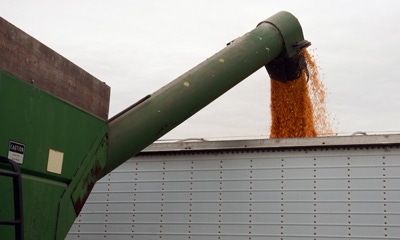August 26, 2016

Weather is good for crops this year. It’s also generally favorable for ear and stalk rots. The amount of rain received during the grain-fill period is related to the amount of kernel and ear rots that develop. Many areas received lots of rain in August.
Corn Illustrated 8/22: Should you use foliar fungicides in corn?
Most of the fungi that cause these diseases overwinter in stored grain and on the soil surface in crop residue. Continuous corn tends to increase incidence of these diseases. Crop rotations tend to keep soils healthy and reduce incidences of these diseases.
Since no one knows which ear rots will be significant this year, this article discusses the five most important ones.

CHECK FOR MOLD FIRST: Once corn is harvested, it’s impossible to sort out infected grains. Aflatoxin can be detected, however.
1. Diplodia ear rot is caused by the fungus Diplodia maydis.
These infections occur within two weeks after silking. The shank and husks look bleached or straw-colored. Infection usually starts at the base of the ear and later spreads to the kernels. Eventually, the whole ear may rot. When husks are peeled back, a white mold is visible between kernel rows.

(Photo courtesy of Chuck Woloshuk, Purdue plant pathologist)
2. Gibberella ear rot is caused by the fungus Gibberella zeae.
This rot starts at the tip of the ear. Kernels become reddish as the disease spreads to the entire ear. Gibberella ear rot is toxic to pigs, causing vomiting, weight loss and even death. Pigs refuse to eat infected corn on the ear if 5% to 10% of ears are rotten.

(Photo courtesy of Chuck Woloshuk, Purdue plant pathologist)
3. Fusarium ear rot is caused by the fungus Fusarium moniliforme.
This disease produces pink to red discoloration of the kernels and usually starts at the tip of ears. Infected kernels become covered with pink mold, which contains millions of microscopic spores. You may notice either scattered groups of kernels or a starburst pattern with mold threads radiating out from a central spot if it’s fusarium ear rot.

(Photo courtesy of Chuck Woloshuk and Purdue University Department of Botany)
4. Aspergillus ear rot is caused by the fungus Aspergillus flavus.
This disease can become important in hot, dry seasons. Corn with nitrogen deficiency may be more susceptible. This pathogen infects ears damaged by corn earworms, European corn borers and other insects. It’s commonly found on ear tips. High temperatures favor development and spread of this disease. It produces bluish-green to green mold on the kernels. The fungus produces aflatoxin, which is carcinogenic and can cause serious feeding problems in animals and human food. In stored grain, it can cause major losses because grain containing aflatoxin may be rejected by elevators based on strict limits set by the Food and Drug Administration and USDA.

(Photo courtesy of Chuck Woloshuk, Purdue plant pathologist)
5. Corn smut is caused by the fungus Ustilago zeae.
This disease is easily recognized. It produces big galls of plant tissue that are full of black spores. It can attack any part of the plant. Spores usually enter the plant through injury from insects or mechanical damage. If smut occurs on the lower parts of the plant, it can cause barrenness. Dry weather or abnormally cool, wet weather is conducive to smut infection.
Corn Illustrated 8/15: Corn groups continue to use NASCAR tie to promote E15 fuel
Corn breeders try to discard parent lines and hybrids that are susceptible to these pathogens. Hybrids with good tolerance to many of these diseases are available from many companies.
Visit seed company field days and study hybrids just before harvest. Select those that show resistance to ear rots. Avoid hybrids with poor husk cover or weak seed coats.
Nanda is president of Agronomic Crops Consultants LLC, Indianapolis. Email him at [email protected], or call him at 317-910-9876.
You May Also Like




